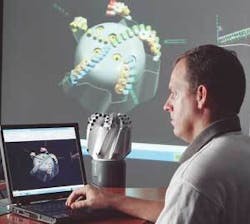Choosing the Right Bit
Drilling programs throughout the world are now more challenging in terms of depths, well profiles, and formation drillability (often determined by hardness and/or abrasiveness). Drill bit manufacturers are commonly expected to develop products that drill faster and/or longer in these harsher environments. Even though there have been impressive technological advancements in bit design and performance, operators are demanding yet more from the bit. For instance, they may want a bit to drill an entire section as fast as practical which translates into one fast run in a hole size. They may require a precise target TD with low tolerances for error. They may want the perfect bit. More often than not, this almost means custom designing a bit for the application, a growing trend in the industry.
What’s Under the Hood?
Making the correct bit choice is one of the key decisions in any successful drilling operation. Bits look the same but they are analogous to Formula One race cars. It’s the science and analysis underneath that really determines the winner. The bit has to be right for the application, geologic formation, and rig/equipment capabilities. Before making the choice, engineers normally evaluate formations to be drilled, previous dull conditions, and projected operating parameters to ensure maximum performance. However, a few things have changed. Bit optimization and selection have to now consider the entire system and the environment. For best performance, bits today have to be compatible with drilling fluids and they have to be compatible with motors, especially a rotary steerable system. Shortfalls in bit performance, which may seem insignificant in terms of cost, have drastic effects on overall well costs. Considering the technological advancements that continue to be made, optimizing and selecting the right bit has become a very critical investment. The process for doing so has undergone a dramatic modernization.
Historical Perspectives
Over the years, the drill bit selection process mostly depended upon an operator’s past experience in offset wells. If lucky, the company’s drilling engineer on the job might have drilled some of the offsets. The drilling contractor also contributed input. The plan usually involved a survey of historical bit record databases that indicated how certain bit types reacted in the formations predicted for the upcoming well. The process was often subjective rather than objective decision making. Key information was combined with bit manufacturers’ technical data on specific products, to yield a list of bits or bit types that could be used to drill a borehole as clean and as close to gage as possible in the least amount of time, given safety requirements and cost limits. Drilling engineers often selected bits because they were the “best performer” in a particular area. Normally, it took considerable time to gather the necessary historical data, and the estimated outcome still remained somewhat in doubt.
The flaw in this singular approach is that performance data from offset wells reflects a complex relationship between drilling parameters, well path, formation properties, drilling fluid properties, hydraulics, and bit design. Unfortunately, all these variables are seldom considered in reviewing only bit records. Looking purely at cost-per-foot via performance data is still a good reference system, but it represents only an economic calculation. Not often does it consider other drilling difficulties such as formation variability and directional drilling conditions. Although still an accepted method today, the usefulness of first blush performance data has drastically been reduced because of modern methodologies. Today, making the right decision often times requires the merging of specialized application tools, processes and multiple disciplines that aid in bit-selection and optimization. The goal of all of this is to improve the timeliness and correctness of decisions. Many operators and manufacturers are also performing a more comprehensive analysis of previous drilling performance to look at what problems were encountered and determining if they were bit related. Undoubtedly, the level of sophistication in decision-making and predictability has increased.
Understanding the Variables
For some time there have been major initiatives to better model and/or predict drill bit selection and evaluate performance. Advancements in software/hardware and the broad use of drilling measurement systems (such as logs taken to measure compressive strengths) have increased, so more data is available and it can be analyzed in many different ways. Almost all the approaches are similar in objective, to make drilling bit selection less erroneous and more logical. Evaluation methods unfortunately have not always kept pace with the technological advancements. The number of interrelated variables to analyze continues to grow as more data is collected in a technologically dynamic drilling environment. One thing has stayed the same. At the minimum engineers still look at previous bit records, formation types and operating conditions before any bit recommendations. At their best, engineers provide a premium service and typically do more analysis upfront to match rig capabilities, formation, motor, directional requirements, lithology, etc.
Risk has also entered into the bit selection equation today. If you have a catastrophic failure downhole with expensive drilling and measurement systems, it’s expensive and a lost opportunity for everyone including the service provider who has to rebuild and replace the lost tool, losing revenue along the way. Bit and equipment reliability is a key variable. In a time when the industry is trying to cut costs and improve drilling performance, more companies strive to better understand their exposed project risks and rewards based on capital investment. Drilling optimization practices and techniques are now used to improve risk management by improving equipment selection and performance prediction, helping operators assess the amount and impact of investment required for a given drilling project.
More Tools Aid Bit Selection Today
There are a broad variety of engineering services, software and tools that have been developed by operators and manufacturers to optimize bit performance and selection. These range from high math to high touch.
• ROP algorithms are now used frequently as a drilling optimization tool to model the technical limit ROP expected through a given hole interval. Inputs include detailed lithological descriptions of the anticipated formations, hole size, mud weight, predicted pore pressure, bit type, and anticipated operating parameters. The ROP predictions improve drilling decisions, provide performance analysis and guide financial planning.
• Advanced bit modeling capabilities are broadly in use and many are “customized” for specific applications, rock properties and drilling parameters. Drilling model simulations often show how cutting forces are affected during transitional drilling, common in “hard rock” environments. Bit design is then balanced to optimize axial, lateral, and torsional forces. Features such as profile shape, cutter rake angles, impact arrestors, and cutter type are tweaked. Years ago, predecessor modeling techniques investigated the interaction between the cutting elements of a PDC drill bit and the formation drilled. Principles were identified to bring about anti whirl and force balanced PDC bit designs. This led to the introduction of low friction gages and different cutter arrangements. Historically, modeling tools have improved the bit design process in many areas including the development of new cutting structures to minimize damaging bit vibrations and/or PDC-cutter wear.
Bit manufacturers have also deployed a mix of tools and processes to aid in the operator’s bit selection and optimize performance.
• Hughes Christensen uses a Design Application Research Team (DART) process that merges field personnel, the customer, research people, and bit design experts. As a team, they gather all data and requirements to make better decisions about bit attributes and operating parameters for the optimum solution. “We feel it’s important to bring together multiple disciplines to take advantage of all the data available in decision making,” says Evan Turner, Director of Marketing Services for Hughes Christensen. “Software is a tool the bit selection technologist uses, but the human element is still important. Our process has been highly successful and we hold DART meetings every day with customers around the world. It’s now a way of doing business. On large projects a more extensive effort is used such as our OASIS pre-drill studies and real time monitoring.”
• Recognizing each well as a unique challenge for the customer, Security DBS employs various tools to provide a value-added solution under a Drilling by Design umbrella. Modules help develop “matched system” solutions to address specific issues related to the well’s architecture. Application Design Evaluation (ADE) specialists help shorten the learning process as does DatCI (Design at the Customer Interface). This often allows new designs to be developed and produced fast enough to be employed in the same section of the very next well. In longer drilling programs, Scientific Planning and Real Time Applications (SPARTA) analytical tools are used to analyze drilling mechanics and rock strength and optimize well solutions.
• In the same vein, Smith Bits uses Advanced Services Engineering (ASE) teams to bring drill bit expertise and local knowledge together in an effort to reduce drilling costs. Knowledge from the Smith Bits Drilling Records System is used to analyze offset wells. A multi disciplined Drill Bit Optimization System (DBOS) can also determine the optimum cutting structure, gage protection, hydraulic configuration, and other bit design features for drilling. At the highest level of DBOS service, Smith prepares contour maps of field “drillability” trends to map regional variations in formation drillability on an interval-by-interval basis.
To optimize the bit design process itself, manufacturers have developed their own state-of-the-art tools.
• Varel uses a process called Advanced Force Balancing in all of its fixed cutter products. While force balancing has been used since the mid 1980s, Advanced Force Balancing significantly improves rate of penetration (ROP), dull bit condition and deviation control over conventionally balanced PDC bits. The theory of force balancing is to minimize the resultant side force by strategic adjustment of individual cutter side rake and back rake.
Expert systems are also used in the field, often co-joining providers and operators. For instance, Baker Hughes developed an expert system to improve risk management for a Canadian Natural Resources Ltd. (CNRL) project in Western Canada. Drilling optimization programs were used for drill bit selection and software to predict the achievable rate of penetration. These systems usually have a highly complex set of rules which model drill bit features according to the physical properties of the drilling environment under study.
The ultimate bit optimization tool may be verification of actual performance while drilling. Some companies are investigating the utilization of technology with wired drill pipe to give a high frequency, real time picture of drilling dynamics downhole. Unencumbered by the limits of traditional MWD transmission rates, real time drilling optimization may become a reality in the short term.

